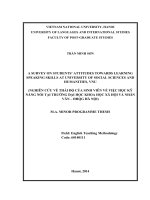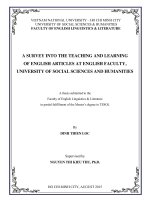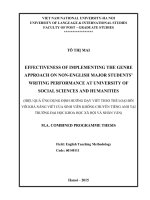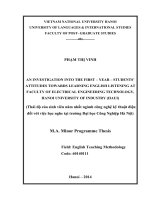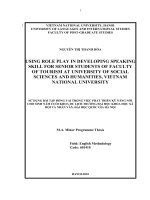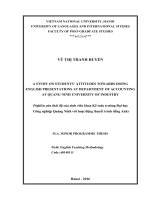A SURVEY ON STUDENTS’ ATTITUDES TOWARDS LEARNING SPEAKING SKILLS AT UNIVERSITY OF SOCIAL SCIENCES AND HUMANITIES, VNU
Bạn đang xem bản rút gọn của tài liệu. Xem và tải ngay bản đầy đủ của tài liệu tại đây (1.02 MB, 69 trang )
VIETNAM NATIONAL UNIVERSITY, HANOI
UNIVERSITY OF LANGUAGES AND INTERNATIONAL STUDIES
FACULTY OF POST-GRADUATE STUDIES
TRẦN MINH SƠN
A SURVEY ON STUDENTS’ ATTITUDES TOWARDS LEARNING
SPEAKING SKILLS AT UNIVERSITY OF SOCIAL SCIENCES AND
HUMANITIES, VNU
(NGHIÊN CỨU VỀ THÁI ĐỘ CỦA SINH VIÊN VỀ VIỆC HỌC KỸ
NĂNG NÓI TẠI TRƢỜNG ĐẠI HỌC KHOA HỌC XÃ HỘI VÀ NHÂN
VĂN – ĐHQG HÀ NỘI)
M.A. MINOR PROGRAMME THESIS
Field: English Teaching Methodology
Code: 60140111
Hanoi, 2014
VIETNAM NATIONAL UNIVERSITY, HANOI
UNIVERSITY OF LANGUAGES AND INTERNATIONAL STUDIES
FACULTY OF POST-GRADUATE STUDIES
TRẦN MINH SƠN
A SURVEY ON STUDENTS’ ATTITUDES TOWARDS LEARNING
SPEAKING SKILLS AT UNIVERSITY OF SOCIAL SCIENCES AND
HUMANITIES, VNU
(NGHIÊN CỨU VỀ THÁI ĐỘ CỦA SINH VIÊN VỀ VIỆC HỌC KỸ
NĂNG NÓI TẠI TRƢỜNG ĐẠI HỌC KHOA HỌC XÃ HỘI VÀ NHÂN
VĂN – ĐHQG HÀ NỘI)
M.A. MINOR PROGRAMME THESIS
Field: English Teaching Methodology
Code: 60140111
Supervisor: NGUYỄN ĐỨC HOẠT, PhD
Hanoi, 2014
i
DECLARATION
I, Tran Minh Son, hereby declare that the thesis entitled: “A survey on students’
attitudes towards learning speaking skills at University of Social Sciences and
Humanities, VNU” is the result of my own research in the fulfillment of the
requirements for the degree of Master of Arts. Moreover, this thesis has not been
submitted anywhere for any degree.
Hanoi, 2014
Author’s signature
Trần Minh Sơn
ii
ACKNOWLEDGEMENTS
I would like to express my affectionate and deeply-felt gratitude to my
supervisor, NGUYEN DUC HOAT, PhD for his invaluable assistance, inspiration
as well as guidance during the time I tried to accomplish this thesis.
I owe my sincere thanks to all the lecturers in Postgraduate Department of
University of Languages and International Studies for their precious lectures and
ideas.
Moreover, I would like to send my thanks to the lecturers and students at the
University of Social Sciences and Humanities, VNU for their enthusiastic co-
operation in this study.
Finally, I am also deeply indebted to my family who has supported me
vigorously. Their great love and encouragement have assisted me in completing this
thesis more successfully.
iii
ABSTRACT
Speaking is considered one of the most challenging skills which the EFL
students at the University of Social Sciences and Humanities, VNU are facing.
Their ability to speak English is generally limited. Therefore, the study is conducted
with the aim of exploring the students’ attitudes towards learning speaking skills.
Because the study is a survey, questionnaire and semi-structured interviews are
applied as main instruments of the study. The participants in the questionnaire
consist of 150 first-year non-English major students (both males and females) from
six classes, and thirty students in the interviews (12 males and 18 females) selected
randomly from the 150 questionnaire respondents. The findings from these two
instruments have demonstrated that the students of the University of Social
Sciences and Humanities, VNU have a positive attitude towards learning speaking
skills. Most of them are aware of the importance of English speaking skills and feel
comfortable to learn them. However, their teacher’s fast speed of speaking is
considered as the least positive factor involved in the students’ attitudes towards
learning speaking skills. In addition, based on such findings, the researcher has
offered suggestions for both lecturers and students to improve the lecturers’
teaching speaking skills and the students’ ability to speak English.
iv
TABLE OF CONTENTS
DECLARATION………………………………………………………
ACKNOWLEDGEMENTS……………………………………………
ABSTRACT……………………………………………………………
TABLE OF CONTENTS………………………………………………
LIST OF ABBREVIATIONS…………………………………………
LIST OF FIGURES……………………………………………………
PART A: INTRODUCTION……………………………………………
1. Rationale ……………………………………………………………….
2. Aims of the study ……………………………………………………
3. The research questions…………………………………………………
4. Significance of the study ………………………………………………
5. Scope of the study …………………………………………………….
6. Methods of the study ………………………………………………….
7. Structure of the study …………………………………………………
PART B: THE STUDY………………………………………………….
Chapter one: LITERATURE REVIEW……………………………….
1.1. Speaking skills and attitudes ………………………………………
1.1.1. Speaking skills ……………………………………………………
1.1.2. Attitudes…………………………………………………………
1.2. The elements of speaking ……………………………………………
1.3. The communicative approach in teaching English speaking skills….
1.4. The roles of attitude in language learning ………………………….
1.5. The roles of attitude in learning speaking skills……………………
1.6. Previous research…………………………………………………….
1.7. Summary ……………………………………………………………
Chapter two: METHODOLOGY………………………………………
2.1. Research questions…………………………………………………
Page
i
ii
iii
iv
vi
vii
01
01
01
02
02
02
03
03
05
05
05
05
06
07
08
10
11
12
13
14
14
v
2.2. The setting……………………………………………………………
2.3. The participants………………………………………………………
2.4. The data collection instruments………………………………………
2.5. The data collection procedure………………………………………
2.6. The data analysis procedure………………………………………….
2.7. Summary……………………………………………………………
Chapter three: FINDINGS AND DISCUSSION………………………
3.1. What are the students’ attitudes towards learning English speaking
skills at USSH, VNU?
3.2. What are the factors influencing the students’ attitudes?
3.3. What are the suggestions for the lectures and the students? ………
3.4. Summary …………………………………………………………….
PART C: CONCLUSION………………………………………………
1. Conclusions…………………………………………………………….
2. Suggestions for lecturers and students…………………………………
2.1. Suggestions for lecturers……………………………………………
2.2. Suggestions for students…………………………………………….
3. Limitations of the study ……………………………………………….
4. Suggestions for further studies ……………………………………….
REFERENCES…………………………………………………………
APPENDIX 1: Questionnaire (Vietnamese version)………………….
APPENDIX 2: Questionnaire (English version)……………………….
APPENDIX 3: Transcription For Interview…………………………
14
15
16
17
18
18
19
19
29
31
35
36
36
36
36
40
40
41
42
I
VI
XI
vi
LIST OF ABBREVIATIONS
1. USSH,VNU = University of Social Sciences and Humanities, VNU
2. CLT = Communicative Language Teaching
vii
LIST OF FIGURES
Figure 3.1: Students' general attitudes towards liking or disliking
learning English
Figure 3.2: Students' general attitudes towards four English skills
Figure 3.3: Students' attitudes towards the importance of learning
English speaking skills
Figure 3.4: Students' purposes of learning English speaking skills
Figure 3.5: Students' attitudes towards English speaking lessons
Figure 3.6: Students' frequency of the unwillingness to speak English in
speaking lessons
Figure 3.7: Students' activities in speaking lessons
Figure 3.8: Students’ attitudes towards teachers’ teaching methods of
speaking skills
Figure 3.9: Factors influencing students’ attitudes towards learning
speaking skills
Figure 3.10: Students' preference for work arrangements in speaking
lessons
Figure 3.11: Students' comprehension when the teacher explains the
instruction in English in speaking lessons
Figure 3.12: Students’ expectations of learning speaking skills
19
20
22
23
24
26
27
28
30
31
32
34
1
PART A: INTRODUCTION
1. Rationale
In learning English, EFL students at the University of Social Sciences and
Humanities, VNU regard speaking skills as the most challenging skill to learn. They
are not ready to stand up to practice English, even work in groups at English
speaking lessons. Although the researcher is not a lecturer of USSH, VNU, he used
to work as a visiting lecturer of USSH, VNU. Therefore, he had an opportunity to
know thoroughly about the real situation involved in the university’s English
teaching and learning. As for most of the students at USSH, VNU, English is not an
exam subject in their matriculation exam; therefore, they do not usually pay much
attention to it. Moreover, their majors are not English, and they have a tendency to
be more interested in their own majors such as History, Orientalism, and
Philosophy. In English speaking lessons, they do not feel highly enthusiastic about
speaking English. They possess low proficiency in grammar, vocabulary as well as
listening skills, leading to the fact that they are usually unconfident of speaking
English and feels difficult to share their thoughts in English. In the researcher’s
view, it is better for this problem to be enhanced in order to assist students in
making progress in learning English speaking skills.
For the reasons mentioned above, exploring the students’ attitudes towards
learning speaking skills is really essential. By investigating the students’ attitudes
and the factors impacting on those attitudes, the researcher may discover much
more this university’s students’ expectations, from which he can offer suggestions
for ways of improving students’ ability to speak English at USSH, VNU.
2. Aims of the study
The aims of the study are:
- To investigate EFL students’ attitudes towards learning speaking skills at USSH,
VNU.
- To find out factors influencing their attitudes in learning to speak English.
2
- To offer suggestions in order for not only USSH,VNU’s lecturers of English to
develop their students’ ability to speak English at USSH,VNU but also the students
to improve their attitudes towards learning speaking skills.
3. The research questions
The study is conducted in an effort to answer the following research questions:
Question 1: What are the students’ attitudes towards learning English speaking
skills at USSH, VNU?
Question 2: What are the factors influencing the students’ attitudes?
4. Significance of the study
The study provides lecturers of English at the University of Social Sciences and
Humanities –VNU with the findings involved in their students’ attitudes towards
learning English speaking skills. The study will assist the lecturers in grasping their
students’ expectations of learning to speak English.
Furthermore, the research supplies lecturers of English at the University of
Social Sciences and Humanities –VNU with suggestions to help them to enhance
their students’ speaking ability.
5. Scope of the study
The study concentrates on students’ attitudes towards learning English speaking
skills at the University of Social Sciences and Humanities –VNU; however, due to
the time limitation, the researcher will only carry out his survey on the first-year
non-English major students.
6. Methods of the study
To conduct the survey research, the researcher used both qualitative and
quantitative methods. Two main data collection instruments are survey
questionnaire and interview. The survey questionnaire was delivered to students to
3
collect the data related to the study. This was also the main method used in the
study. Then, the interviews with some students took place to attain more
information. The form of interview used in the study was the semi-structured
interview since it would make the researcher more flexible and give the participants
a degree of control during the interview.
The detailed information on methods of the study will be presented in chapter
two: Methodology.
7. Structure of the study
The study consists of three parts.
Part A: INTRODUCTION
This part includes rationale, aims, the research questions, significance, scope,
methods and design of the study.
Part B: THE STUDY
This part is composed of three chapters, as follows:
Chapter 1: Literature review
The chapter presents the previous findings relevant to the study such as the
defintions of attitudes and speaking skills, the elements of speaking, the
communicative approach in teaching English speaking skills, the roles of
attitudes in language learning and speaking skills.
Chapter 2: Methodology
The chapter is involved in the introduction of the University of Social
Sciences and Humanities-VNU – the research place, the information of the
participants, the data collection instruments consisting of the reasons for
choosing the questionnaire and interview and the categories of the twelve
questions in the questionnaire. Moreover, the data collection procedures and
methods of data analysis are also stated carefully.
4
Chapter 3: Findings and Discussion
After collecting the results from the students of the University of Social
Sciences and Humanities-VNU, all the answers to the questions from the
questionnaire and interview are analyzed and discussed logically and in
depth in this chapter. The figures will be presented through tables and
graphs.
Part C: CONCLUSION
This is the last part of the study, which is expected to summarize the main points
of the study, including the summary of findings. Besides, the suggestions are also
addressed to help not only teachers to adapt their teaching methodology to enhance
their students’ speaking ability but also students to improve their attitudes towards
learning speaking skills as well as their English speaking skills.
5
PART B: THE STUDY
Chapter one: LITERATURE REVIEW
1.1. Speaking skills and attitudes
1.1.1. Speaking skills
In language teaching and learning, the manner in which a language is used is
called skills or language skills, and speaking is one of the four skills: listening,
speaking, reading and writing skills (Richards et all, 1992: 205). In teaching and
learning a foreign language in general and English in particular, speaking is one of
the most essential skills because it is said to be the basic for communication;
moreover, speaking skills can be considered a real challenge to learners of English.
Thornbury (2005) states that there is no synonymy between knowing a language
and being able to speak it. Therefore, the statement “He knows English” does not
entail the statement “He can speak English”. From the researcher’s perspective,
speaking skills should be attached special importance to. However, it is essential to
consider the typical definitions of speaking skills by many different scholars.
According to the traditional view, speaking was a by-product of teaching
vocabulary and grammar and was strengthened with tasks on pronunciation.
However, the modern view considers speaking as a real skill, and the speaking
skills can be divided into sub-skills and the purposes of speaking (Thornbury,
2006).
Moreover, when it comes down to speaking skills, Nunan (2003:48) is of the
opinion that speaking is the productive oral skill, which is generated by the learner
of a language in speech. Speaking is composed of using verbal systematic
utterances to express meaning. Bailey (2005) also states that speaking is a verbal
and productive skill and consists of systematically-produced oral utterances.
Nonetheless, Burns and Joyce (1997) as well as Brown (1994) have a different view
that speaking can be understood as an interactive process of meaning construction
that is associated with producing, receiving and processing information.
6
Another term for “speaking” is spoken communication or oral communication. It
is more immediate and natural, so speaking is in need of the parties’ simultaneous
presence and attentiveness (Rai, 2010).
Thus, it is reasonable to state that speaking is a verbal skill and a process of oral
communication. A speaker begins to produce oral utterances, which are received by
a hearer, and then are processed so that the hearer can understand what the speaker
is saying.
1.1.2. Attitudes
The definition of attitude can be understood as an individual’s judgement
towards something, and in general people’s attitudes can be positive or negative in
spite of the fact that they can potentially have ambivalent attitudes (both positive
and negative attitudes) or claim that they have no attitudes (Baker and Ellece,
2011).
Attitude is composed of three components. The first one is the affective
component which is involved in our evaluation of and feelings about the object. The
second one is the cognitive component which is related to our beliefs about the
object, and the last one is the behavioral component, which reflects the intentions of
an individual (Fazio, 1986).
Kumaravadivelu (2006) defines attitudes as “one’s evaluative responses to a
person, place, thing or an event”. He adds that attitude is complicatedly connected
with the processes and practices of language learning. Moreover, Malcolm (cited in
Kumaravadivelu, 2006:39) suggests two external forces shaping the learner’s
language learning attitudes, namely the environmental force and the pedagogic
force. The environmental one consist of social, cultural and economic imperatives,
and the pedagogic one consisting of the interaction between teachers, students and
the learning situation to result in positive and negative attitudes.
7
Thornbury (2006) also presents that an individual’s attitude towards learning a
language is the way he or she feels about, and the individual’s attitude towards
language learning can be positive or negative.
To sum up, attitude is to talk about a person’s opinions, feelings and beliefs. In
other words, it mentions the way which he or she thinks about, feels about and
behaves towards somebody or something. Furthermore, two components of attitude
focused upon in the study are the cognitive component and the affective component.
1.2. The elements of speaking
Rai (2010) mentions the voice dynamics, intonation, speech, stress, volume and
accent, which are considered as momentous elements in spoken language.
Sufficiently, Harmer (2001) suggests many elements of speaking which belong
to two aspects, namely language features and mental/social processing, when
mentioning the fluency in speaking.
Language features consist of connected speech – expressing fluent connected
speech including elision, assimilation, contractions, stress patterning, and linking
“r”; expressive devices to convey meanings such as the pitch, stress, volume, speed,
physical and non-verbal means; lexis and grammar – using a number of common
lexical phrases for different functions, for example agreeing or disagreeing,
expressing approval, surprise, shock and so on; negotiation language used to find
out clarification and to show the structure of our utterance. Bygate (1987) also
mentions the term involved in the negotiation, namely “negotiation of meaning”
referring to the skill of communicating ideas obviously.
The mental/social processing is involved in the rapid processing skills that are
very necessary. Harmer (2001) also presents three elements, namely language
processing, interacting with others and on-the-spot information processing. The
language processing is related to “the retrieval of words and phrases from memory
and their assembly into syntactically and propositionally appropriate sequences”
(p.271). The interaction with other people includes listening, an understanding of
8
other people’s feelings. The on-the-spot information processing means that a
speaker can process the information another speaker tells him or her as soon as he
or she receives it.
To sum up, there are many elements of speaking in the language features and the
mental/social processing. A speaker should have knowledge of language features,
together with the ability to process information and language immediately.
Language features are composed of four elements necessary for spoken production,
namely connected speech, expressive devices, lexis and grammar and negotiation
language. When the speaker has these language features, the mental/social
processing will assist him or her in achieving successful communication goal.
Processing skills consist of three elements such as language processing, interacting
with others and on-the-spot information processing.
1.3. The communicative approach in teaching English speaking skills
The communicative approach is also called communicative language teaching.
Nunan (1989) have an overview of CLT, as follows: in CLT, language is considered
as a system for communication and conveying meaning. Activities used in CLT are
related to real communication, meaningful tasks. Objectives in CLT reflect learners’
needs and they are composed of functional skills and linguistic objectives. In CLT
classrooms, students act as an interactor and a negotiator, and teachers act as a
facilitator. Harmer (2001:84) defines CLT as “the name which was given to a set of
beliefs which included not only a re-examination of what aspects of language to
teach, but also a shift in emphasis in how to teach”. He also adds that CLT
highlights the significance of language functions and the idea that language learning
will take care of itself, and CLT includes activities associated with real
communication, in which the accuracy is not as important as the achievement of
communicative tasks.
9
According to Richards and Rodgers (2001), CLT refers to a various set of
principles reflecting a communicative view of language and language learning.
Below are the principles:
* Students use a language for communication when learning it.
* The goal of classroom activities is to communicative authentically and
meaningfully.
* An important element in communication is fluency.
* Four language skills should be integrated in communication
* CLT appreciates learning as a process of creative construction and learns by trial
and error.
There are five main characteristics emphasizing the current applications of CLT,
suggested by Johnson and Johnson (cited in Richards and Rodgers, 2001). Firstly,
appropriateness means the use of language must be appropriate to each situation and
learners need to use formal as well as informal styles of speaking. Secondly,
message focus is the characteristic that wants learners to be able to understand and
convey messages or real meanings. The third characteristic is psycholinguistic
processing in which learners are engaged in the use of cognitive processes
important in second language acquisition. Risk taking is the fourth characteristic
which requires learners to make guesses and learn from their mistakes or errors. The
last one is free practice in which the use of holistic practice, involved in the
simultaneous use of different sub-skills, is appreciated.
Communicative language teaching uses more interaction-based activities, for
instance information gap tasks and role-plays. Moreover, two typical organizational
features of interaction-based lessons in CLT are group-work and pair-work (Bailey,
2005:19). In other words, group-work and pair-work are two typical ways in which
a teacher can group his or her students in a CLT classroom.
One of the approaches can be applied in teaching English speaking skills is
communicative language teaching because speaking can be more effective by
applying this approach to teach, and it is likely to enhance students’ speaking
10
achievement. According to the article “A Comparison of Learners’ and Teachers’
Attitudes Towards Communicative Language Teaching At Two Universities In
Vietnam” by Khoi Mai Ngoc and Noriko Iwashita (2012), not only students but also
teachers have positive attitudes towards communicative language teaching
approach. Thus, it can be said that CLT is the appropriate approach to apply to teach
English speaking skills. However, designing various activities for speaking skills in
order to assist students in interacting spontaneously can still be the challenge in
CLT classroom.
1.4. The roles of attitude in language learning
First of all, it is essential to understand of what language leaning is. Davies and
Pearse (2000) affirm that language learning is a long process of acquiring a
language through exposure to the language and its use to communicate and many
unavoidable mistakes can occur.
Learner’s attitudes in language learning play an important role. They are
involved in the success which learners have in learning a language (Lightbown and
Spada, 1993). Gardner (1985) points out three ways of classifying attitudes. The
first one is attitudes that have a dimension of specificity or a dimension of
generality. For instance, it seems to be specific to mention attitudes towards
learning English; whereas, attitudes towards learning foreign languages has a
general dimension. The second one is about attitudes’ relevance to second language
achievement. In this case, there are attitudes which are more connected with the
tasks of learning a second language than other attitudes. The last classification is
based on educational attitudes or social attitudes. Attitudes towards the course, the
teacher, and learning a language are typical examples of educational attitudes while
social attitudes concentrate on the cultural implications of acquiring a second
language. Besides, one of the reasons for the importance of attitudes presented by
Baker (1992) is that attitudes towards a language seem to be momentous in the
restoration, preservation, decay or death of the language. Therefore, it is reasonable
11
to state that the role of attitudes towards a language or language learning is not
minor.
According to Tsiplakides and Keramida (2010), students possessing positive
attitudes towards language learning are less likely to suffer from the anxiety over
language learning and more capable of taking part in learning tasks eagerly.
Ellis (1994) suggests that learner’s achievement and their attitudes have a
relationship with each other in learning a language. Attitudes and learners’ second
language competency influence mutually. If learners gain success, their attitudes
towards learning a language will be positive, and the attitudes may be more
negative if the success does not come. Rebecca L. Oxford (edited in Carter and
Nunan, 2001:168) also affirms that the learners’ language learning can be reduced
and harmed by negative attitudes, but it can be increased by positive ones.
Furthermore, Shimizu (cited in Lieb, 2009) believes that if students have
negative attitudes towards their teachers, these students’ motivation in the
classroom as well as their desire to go on learning the language will be impacted
adversely. This proves that the role of attitudes is significant, and what’s more, it is
essential to inspire or stimulate learners’ long language learning.
In brief, the position of attitudes is dominant in language learning. Language
learning is facilitated by positive attitudes. For example, suppose that the learners
hesitate to learn a language or they do not possess positive attitudes, any result may
not be produced. Moreover, language learning is also influenced by learners’
attitudes and motivation. Their perceptions are related to their attitudes. A learner’s
perceptions of the teacher, the class and his or her awareness of future needs impact
his or her attitudes towards language learning, too. Therefore, not only are attitudes
appreciated in language learning but also studying them a lot should be paid
attention to, which is because the role of attitudes is essential, and it can create the
learners’ success as well as the failure in their language learning.
12
1.5. The roles of attitude in learning speaking skills
The learners’ success in language learning and the effectiveness of their English
course are usually evaluated by them through the progress they feel they have made
in their proficiency in speaking (Richards, 2009). Thus, it can be said that the
learners’ attitudes towards their progress play an important role in the success in
language learning.
When mentioning attitudes in speaking, Quyen Thi Thuc Bui and Channarong
Intaraprasert (2013) believe that the learners who possess positive attitudes towards
English speaking skills are going to be far more involved in speaking activities, and
they have a tendency to make use of more ways which assist them in coping with
their difficulties during the conversation. On the contrary, the learners who have
negative attitudes will tend to be unwilling or less willing to take part in speaking
activities. Thus, it can be inferred that the learners’ attitudes in learning speaking
skills still play a vital role, which decides the learners’ desire to learn speaking.
Besides, Horwitz, Horwitz and Cope (1986) mention the components of foreign
language anxiety in their article. One of them is communication apprehension,
which can be understood as an attitude “characterized by anxiety about or fear of
communicating with people”. In other words, this attitude occurs when an
individual feels nervous and afraid of communicating with other people. Therefore,
when the learners are anxious to speak English, this will also influence their
learning.
To sum up, the attitude has a great impact on learning speaking skills. Its roles
are appreciated, for it is one of the factors that come to a decision about whether the
learners can learn speaking skills successfully or not. According to Davies and
Pearse (2000), that the learners can use English in communication both inside and
outside the classroom is really real success in English language learning. Thus, it is
very necessary to study their attitudes in order to find out ways of improving their
positive attitudes towards learning speaking skills.
13
1.6. Previous research
The studies involved in “students’ attitudes” and “speaking skills” were
conducted by many researchers all over the world. Typically, there are two studies
that the researcher has known, such as the article “attitudes towards English
language learning in Higher education in Japan (2): Raising awareness of the
notion of global English” by Sanae Tsuda in Intercultural Communication Studies
XII-3 2003 and the MA thesis “Students’ attitudes towards learning to speak
English at Ly Thai To High School, Bac Ninh” by Ba Thi Hien in 2012. The first
one mentioned attitudes towards English learning in general; its object of study was
the first and second year students at university. However, the second one mentioned
attitudes towards learning to speak English, but its object of study was the 10
th
graders at a high school.
The researcher’s topic concentrated on students’ attitudes towards learning
speaking skills; however, the setting and the object of study were different. The
setting was at USSH, VNU and the object of study focused on the first-year non-
English major students.
1.7. Summary
This chapter has presented previous research involved in the following aspects:
the defintions of speaking skills and attitudes, the elements of speaking, the
communicative approach in teaching English speaking skills, the roles of attitude in
language learning, the roles of attitude in learning speaking skills. All the
theoretical information mentioned above focuses on speaking skills and attitudes,
which are used as the basis for the data analysis related to the study on students’
attitudes towards learning English speaking skills at the University of Social
Sciences and Humanities, VNU.
14
Chapter two: METHODOLOGY
2.1. Research questions
The study is expected to solve two research questions, as follows:
1. What are the students’ attitudes towards learning English speaking skills
at USSH, VNU?
2. What are the factors influencing the students’ attitudes?
To carry out this, the researcher decided to choose the survey research because
of its advantages. Survey research is suitable for the study with a large population.
The data in this study were collected through a combination of the questionnaire
and interviews, the two typical data collection instruments in the survey research.
The questionnaire was expected to offer the best description of the students’
attitudes towards learning speaking skills at USSH, VNU through significant
statistics. However, during the process of completing the questionnaire, the students
might circle the choices that were not similar to their thoughts or opinions because
they might be afraid to make their teachers sad if their answers had a tendency to
criticize their teachers. Therefore, the researcher used the interview more to have an
opportunity to talk directly with some of the students participating in the
questionnaire with the aim of increasing the reliability of the questionnaire, which
made the study more reliable.
2.2. The setting
The survey is carried out at USSH, VNU, which is located at 336 Nguyen Trai
Road – Thanh Xuan District – Hanoi – Vietnam.
Most of the students are not English majors, and this survey is conducted on the
first-year non-English major students. There are 30 classes which consist of the
first-year students. Each class has approximately 15 to 30 students. In the first year,
students have to learn two course-books, New English File – elementary for the first
term (equivalent to level A1) and New English File – pre-intermediate for the
15
second term (equivalent to level A2). Furthermore, students have to attend two
English classes every week.
Although students have learned English for nine years, their English in general
and their English speaking proficiency are not good. This study is expected to find
out whether they have positive or negative attitudes towards learning speaking skills
and why they have those attitudes, from which the suggestions will be made to
enhance the students’ ability to speak English.
2.3. The participants
To investigate the students’ attitudes towards learning English speaking skills,
the researcher chose 150 students (both males and females) from six classes
FLF1105 1, FLF1105 2, FLF1105 6, FLF1106 10, FLF1106 29, FLF1106 30. The
number of students in each class ranged from 20 to 30 people. These students come
from different parts of Vietnam. They reach Hanoi to go to university. At USSH,
VNU, they have to learn English as a compulsory subject although it is not their
major. Their majors are History, Orientalism, and Philosophy. Moreover, when they
are learning English at university, the course-book and the self-study materials are
their main learning tools. The researcher chose these students as the participants of
the study because all of them have been learning English since they were in grade 3
or 4; however, their English is rather weak, especially speaking skills. Furthermore,
they are not confident of using English to communicate with their partners in
English classes. Therefore, the researcher would like to have a bird’s eye view of
their attitudes towards as well as their expectations of learning English speaking
skills so that he can make suggestions about improving the students’ English
speaking skills at USSH, VNU.
2.4. The data collection instruments
Seeing that the study is a survey used to gain the information of attitudes,
conditions or events at a single point in time (Nunan, 1992:140), the researcher
decided to use two various instruments, namely survey questionnaire and interview.
16
Firstly, questionnaire is one of the typical instruments in the survey research.
This technique is used the most widely in order to gain data from participants;
moreover, it is said to be economical and have standardized questions (McMillan
and Schumacher, 1993). Richards et all (1992) states that the questionnaire is a
group of questions about a topic designed to be answered by participants in a study.
It is very important that a questionnaire should be valid, reliable and unambiguous.
Two types of questions often appearing in a questionnaire are closed questions and
open questions. With closed questions, the researcher will design the range of
possible choices for respondents to be able to choose, whereas with open questions,
respondents can decide what they want to say and how they say it.
The questionnaire in this study includes 12 questions, which are both closed and
open ended. The researcher asked the students to give further information to explain
their choices below each question. Furthermore, all the questions were bilingual in
English and Vietnamese in order that the students can understand the questions
perfectly and precisely. Below are the categories of the twelve questions:
Question 1, 2: students’ general attitudes towards learning English
Questions 3 to 9: students’ attitudes towards learning English speaking skills
Question 10: students’ attitudes towards lecturers’ teaching methods in speaking
classes
Question 11: students’ viewpoints on the factors impacting on their attitudes in
learning English speaking skills
Question 12: students’ possible expectations of learning English speaking skills
Secondly, another instrument is interview. McDonough (2001) considers the
interview as a basic research technique. According to McMillan and Schumacher
(1993), the interview is fundamentally the vocal questionnaire and the distinction
between them is that the interview is associated with direct interaction between
individuals. There are three main types of interviews, namely the unstructured
interview, the semi-structured interview and the structured interview. The interview
designed in this study is the semi-structured interview. the reason why the

